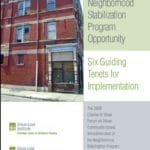Top Story
2009 Shaw Forum – Maximizing the Neighborhood Stabilization Program Opportunity
October 28, 2009
On October 14, 2009, thanks to the generous support of the Annie E. Casey Foundation and the late Charlie Shaw, more than 25 hand-selected public and private sector leaders from across the country gathered at the Biltmore Hotel in downtown Los Angeles to kick off the ninth annual ULI Shaw Forum. Unlike the stars of Hollywood’s Golden Age who came to the Biltmore for the Oscars, these modern land use leaders came to roll up their sleeves and dive into the pressing topic of neighborhood stabilization. Given the economic meltdown and the correlating rise in foreclosures and their deleterious effects on communities across the nation, the issue of neighborhood stabilization could not be more urgent. Specifically, ULI hoped to examine the federal government’s Neighborhood Stabilization Program by assembling experts in the field to assess NSP, share information, analyze promising programs, and offer some clarity to localities in the strategic deployment of NSP funds.
Con Howe, managing director of CityView and chair of the forum, kicked off the one and-a-half-day event. Participants heard overviews on NSP and the Neighborhood Community Stabilization Trust (NCST) from Amanda Sheldon Roberts of Enterprise Community Partners and Craig Nickerson of NCST. Following these contextual presentations, the participants gathered at a dinner featuring a lively panel discussion among the mayors of four diverse cities devastated by the foreclosure crisis: John Brenner of York, Pennsylvania; Patricia Christiansen of Port St. Lucie, Florida; Carty Finkbeiner of Toledo, Ohio; and Joey Torres of Paterson, New Jersey. Each mayor shared his or her experience with foreclosures and the use of NSP funds, providing poignant and compelling insights.
On the following morning, the participants reassembled at the offices of Leo A. Daly to begin the day’s work of examining promising approaches that will help communities maximize the NSP opportunity. Participants heard case study presentations by the Atlanta Neighborhood Development Partnership, the Sacramento Housing and Redevelopment Authority, and the Invest St. Paul Initiative. Participants then broke into three groups and addressed a series of questions targeted at neighborhood stabilization efforts. Each group devised its own list of opportunities, challenges, and lessons learned before reconvening and sharing their thoughts with the group as a whole. The findings and key take-aways from this group of experts led to the six tenets for successful implementation that constitute the bulk of this report.
